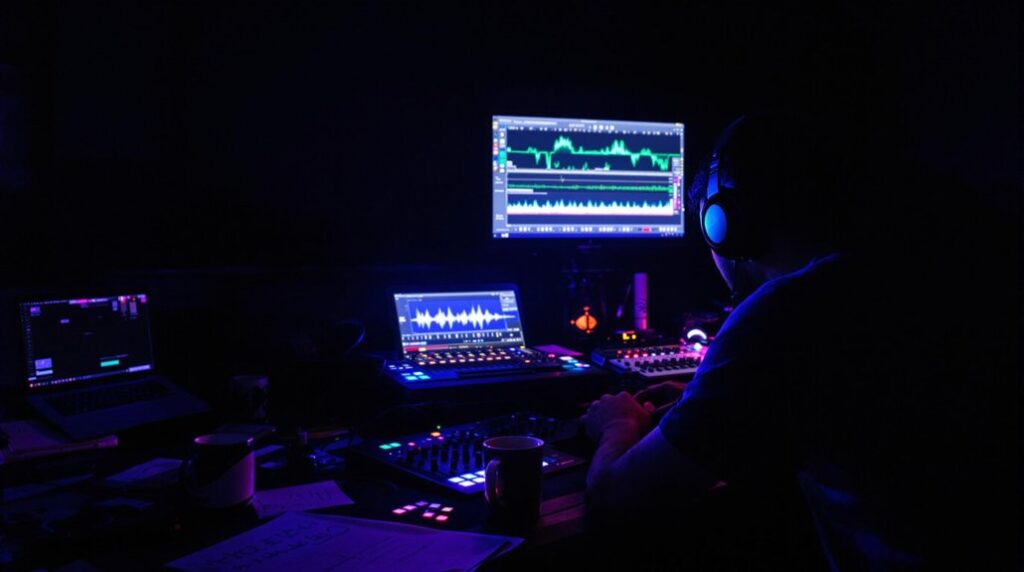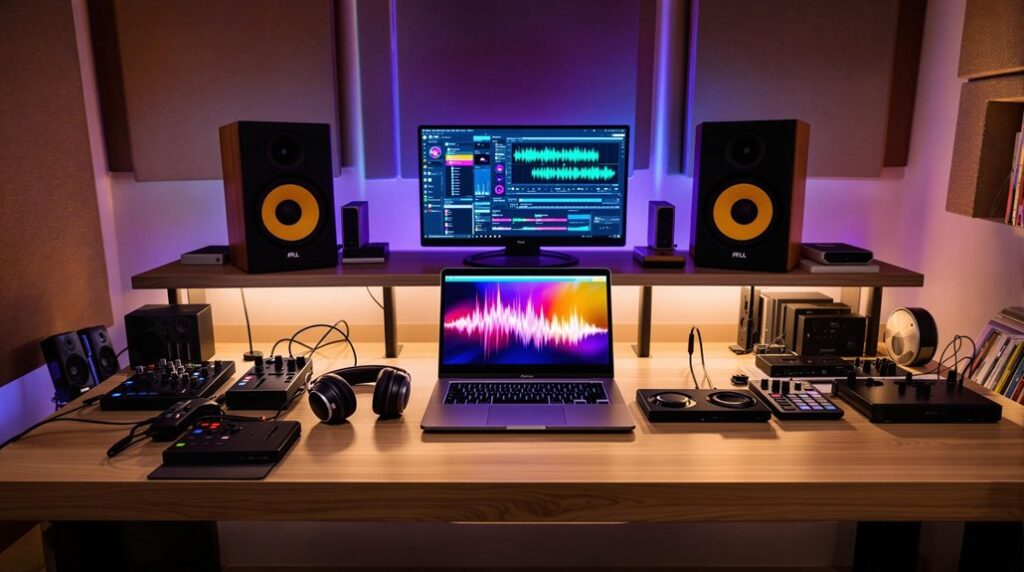To fix vocal problems like sibilance and plosives, start by adjusting your microphone’s placement. Position it slightly off-axis and not too close. Use a pop filter to diffuse harsh sounds and air bursts. For sibilance, employ a de-esser plugin during mixing, setting it to target high frequencies around 5 kHz to 10 kHz. Choose a microphone that suits your voice, with dynamic and ribbon mics being great options. Implement vocal techniques such as maintaining consistent distance from the mic. Post-production enhancement, including EQ tweaks and careful compression, can also help refine vocal quality. Discover more techniques to perfect your sound.
Key Takeaways
- Use a de-esser plugin to compress high frequencies and reduce sibilance effectively.
- Position the microphone slightly off-axis and use a pop filter to manage plosives.
- Select a dynamic or ribbon microphone to naturally minimize harsh sibilant sounds.
- Adjust EQ to reduce harsh frequencies and boost vocal presence between 1 kHz and 3 kHz.
- Employ vocal positioning techniques and maintain a consistent distance from the microphone to avoid plosives.
Understanding Sibilance
Sibilance, the harsh hissing sound from excessive ‘s’ and ‘sh’ sounds, often distracts listeners and degrades your vocal recordings. Understanding the causes of sibilance is essential for preventing it from ruining your audio.
It typically occurs in high frequencies, specifically around 5kHz to 10kHz, and can be exacerbated by certain vocal characteristics, microphone choices, and recording environments.
To prevent sibilance, start by adjusting your microphone placement. Position the microphone slightly off-axis or at an angle to the vocalist’s mouth to reduce the direct impact of harsh sounds. Ensuring the microphone isn’t too close can also help, as proximity can intensify high-frequency sounds.
Another effective method is to use a pop filter. While primarily designed to reduce plosives, these filters also help in minimizing sibilance by diffusing the air before it hits the microphone.
Additionally, consider employing a de-esser plugin during the mixing stage. These specialized tools target specific high-frequency ranges and compress or attenuate them, effectively reducing sibilance without compromising the overall vocal quality.
Choosing the Right Microphone
Selecting the right microphone is essential for achieving high-quality vocal recordings and minimizing unwanted sibilance. When considering condenser vs dynamic microphones, remember that condenser mics are highly sensitive and capture detailed vocals. This sensitivity makes them excellent for studio recordings, but it can also highlight sibilance.
On the other hand, dynamic microphones are less sensitive to high frequencies, which can help reduce sibilance issues. They’re often more durable and forgiving in various recording environments.
Ribbon microphones offer unique benefits, particularly their smooth sound quality. They tend to naturally minimize harsh sibilant sounds, making them an excellent choice for taming sibilance without sacrificing vocal warmth. However, they can be more delicate and require careful handling.
To achieve the best results, match the microphone’s frequency response to the vocalist’s voice. This guarantees a balanced and natural sound. It’s important to experiment with different microphone placements and angles. Adjusting the position can greatly impact the capture of sibilant sounds.
Try positioning the mic slightly off-axis or away from the direct airflow to reduce sibilance. By selecting the right microphone and optimizing placement, you’ll enhance vocal clarity and quality.
Using De-Essers Effectively
When you’re aiming to reduce sibilance in your vocal tracks, using a de-esser effectively can make a significant difference in achieving a polished sound. Start by understanding the key de-esser techniques. Place the de-esser at the beginning or end of your vocal processing chain. This allows you to either tackle sibilance early or smooth out any issues post-processing.
Adjust the range and threshold settings to capture and reduce harsh ‘s’ sounds without affecting the natural vocal tone. Use the side-chain frequency to zero in on those high-mid frequencies where sibilance generally resides. You can choose between wide-band and split-band modes depending on your needs; wide-band affects the entire signal while split-band targets only the sibilant frequencies.
Incorporate Vocal EQ to further refine the vocal quality. Before applying audio compression, using a de-esser can prevent sibilant peaks from becoming overly pronounced during compression.
As part of your mixing tips, always compare the before and after to make sure you’re not over-processing. With these steps, you’ll maintain a natural, balanced vocal sound while effectively managing sibilance in your recordings.
Tackling Plosive Issues
While you’ve tackled sibilance with a de-esser, addressing plosive issues requires a different set of strategies to maintain vocal clarity and quality. Plosives, also known as p-pops and b-bursts, occur due to bursts of air hitting the microphone, disrupting your recording’s clarity.
To combat this, start by employing pop filter solutions. A pop filter, placed between the vocalist and the microphone, diffuses the burst of air, effectively minimizing plosives. Choose a high-quality filter to make sure it doesn’t impact the vocal sound.
Next, consider vocal positioning techniques. Angling the microphone slightly off-axis can redirect the airstream away from the mic, reducing plosives without sacrificing sound quality. Additionally, repositioning the vocalist to maintain a consistent distance from the mic can help.
Here’s a quick reference table for these strategies:
| Strategy | Description |
|---|---|
| Pop Filter Solutions | Use a pop filter to diffuse air bursts |
| Angling Microphone | Position the mic off-axis to redirect air |
| Vocal Positioning Techniques | Adjust the vocalist’s distance and angle from the microphone |
Implementing these practical tips ensures you capture clear, professional-sounding vocals right from the recording stage, minimizing the need for extensive post-production fixes.
Post-Production Tips
Consistently applying de-esser plugins in your post-production workflow can effectively reduce sibilance, ensuring your vocals maintain clarity and professionalism.
Start by selecting a de-esser that allows you to pinpoint the specific frequency range where sibilance occurs, typically between 5 kHz and 8 kHz. Adjust the threshold and sensitivity to catch those sharp ‘s’ sounds without dulling the vocal’s overall brightness.
Incorporate vocal EQ techniques to sculpt your sound further. Use a parametric EQ to identify and reduce any harsh frequencies that might exacerbate sibilance or plosives. A gentle cut around the problematic frequencies can make a significant difference.
Additionally, boosting frequencies between 1 kHz and 3 kHz can enhance vocal presence, making your tracks stand out.
Compression strategies are essential for controlling dynamic range and ensuring a consistent vocal performance. Set a moderate ratio, around 3:1 or 4:1, and adjust the attack and release times to maintain the vocal’s natural characteristics. Fast attack times can tame plosives, while slower release times help preserve the vocal’s sustain.
Frequently Asked Questions
How Do You Get Rid of Sibilance in Vocals?
Position your vocalist 8 inches from the microphone. Use a de-esser plugin like Fabfilter Pro-DS. Set its side-chain frequency between 5kHz and 10kHz. Consider manual volume automation for precise sibilance control.
How Do You Fix Vocal Plosives?
To fix vocal plosives, adjust microphone positioning to avoid direct airflow. Use pop filters to minimize plosive impact. Employ a high-pass filter and consider a de-esser for additional refinement. Experiment with these techniques for best results.
Can You EQ Out Plosives?
Yes, you can EQ out plosives by attenuating low frequencies, typically around 100-300 Hz. Combine this with proper microphone placement and a pop filter to minimize plosives effectively without compromising your vocal recording’s clarity and natural sound.
How to Remove Sibilance Eq?
To remove sibilance with EQ, use de-essing techniques and precise frequency adjustments. Target the 5kHz to 10kHz range, employing a high-pass filter or notch filter. Always monitor and A/B test to maintain a natural vocal tone.
Conclusion
Mastering vocal clarity involves addressing sibilance and plosives effectively. By selecting the right microphone and using de-essers properly, you can greatly reduce sibilance issues.
For plosives, consider using pop filters and adjusting your mic technique. Don’t overlook post-production tweaks to polish your sound.
With these practical tips, you’ll guarantee your recordings are crisp and professional. Keep refining your approach, and soon, vocal problems will be a thing of the past.




